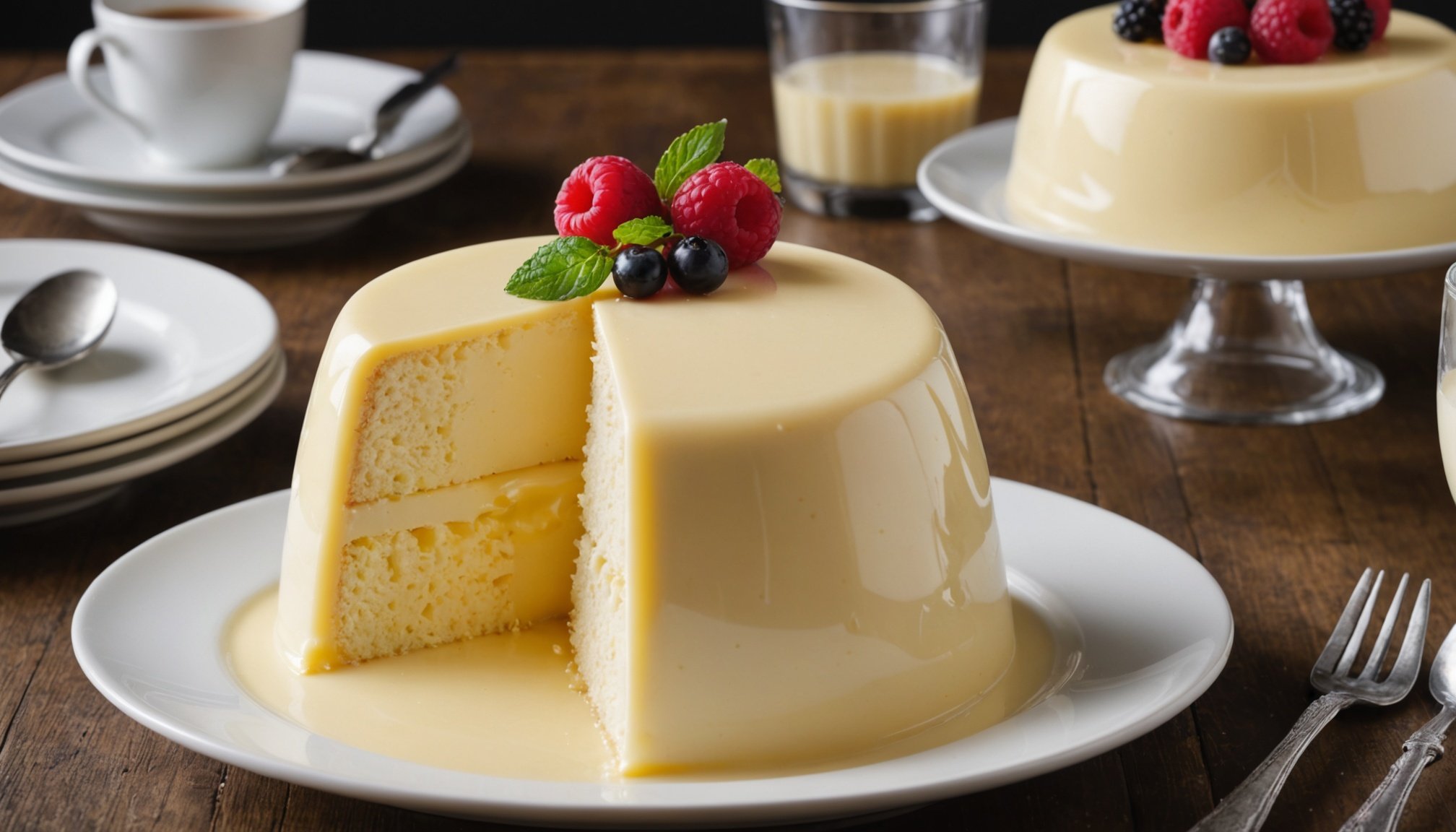Introduction to English Blancmange
Blancmange is a classic dessert that has charmed palates for centuries. This delicate treat is believed to have originated in the Middle Ages, evolving from humble beginnings to become a cherished favourite across Europe. Originally, English Blancmange was a savoury dish composed of shredded chicken or fish, boiled with cream and rice, creating a dish reminiscent of modern-day risotto. As culinary trends shifted, this dish transformed into the sweet, creamy dessert we recognise now.
The traditional recipe for English Blancmange includes ingredients such as milk or cream, sugar, and gelatin, which combine to deliver the signature smooth and creamy texture. Aromatics like vanilla or almond are often added to enhance the flavour, celebrating the dessert’s subtle sweetness. Although the basic recipe remains consistent, variations exist across different cultures. For instance, in France, Blancmange is often flavoured with fruit or chocolate, while in the Middle East, similar desserts might incorporate rosewater or pistachios.
Also to read : Mastering the Art of Creamy English Trifle with Sherry: Your Ultimate Guide!
The importance of achieving a perfect creamy texture cannot be overstated; it’s what distinguishes a well-prepared Blancmange from inferior interpretations. A rich, smooth consistency makes this dessert a versatile base for different ingredients, appealing to a broad spectrum of taste preferences and ensuring its place in the annals of dessert history.
Ingredients for the Perfect English Blancmange
Crafting the perfect English Blancmange begins with selecting the right blancmange ingredients. The essential components include milk, sugar, cornstarch, and a touch of vanilla or almond for flavour. These creamy dessert ingredients form the base of a traditional recipe. High-quality whole milk is recommended for a rich, silky texture.
This might interest you : Mastering the Art of Fluffy Yorkshire Pudding: The Ultimate Guide to Perfect Pan Drippings!
When choosing recipe components, brands like Cornish Farm Dairy and Organic Valley offer excellent milk options. For the cornstarch, Bob’s Red Mill is known for its consistency and quality, ensuring your Blancmange is smooth and lump-free.
For those with dietary restrictions, consider switching out dairy milk for almond or oat milk. Brands like Alpro and Oatly produce substitutions that still yield a lovely texture without compromising the creamy dessert experience. If sugar intake is a concern, use a natural sweetener such as stevia or honey as alternatives.
It’s noteworthy that the choice of flavouring—whether vanilla or almond—can personalize your creation. Use a high-purity extract to enhance the overall taste profile of your Blancmange. By selecting the right blancmange ingredients, you can create an authentic and adaptable version of this classic dish to suit a variety of preferences.
Step-by-Step Preparation Instructions
Are you ready to create the perfect Blancmange? Follow these detailed steps to ensure an easy cooking experience.
Gather Ingredients
Before starting, ensure you have all the necessary ingredients ready. The key to a successful Blancmange is preparation.
-
Preparation: Begin by dissolving your desired flavouring (such as vanilla, almond, or rose water) in milk. Keep stirring to ensure even distribution.
-
Mixing: Gradually add sugar while stirring, making sure it dissolves completely. Use a whisk for optimal results in blending the ingredients smoothly.
-
Thickening: In a separate bowl, mix your choice of thickening agent, like gelatine or cornflour, with a small amount of milk. Slowly combine this with your flavoured milk mixture, stirring continuously to avoid lumps.
-
Cooking: The cooking instructions demand careful temperature control. Heat the mixture slowly over medium heat, continuing to stir. The aim is to reach a gentle simmer without boiling, to maintain the right consistency.
-
Final Step: Once thickened, pour the Blancmange into a mould. Refrigerate for at least 4 hours to allow it to set.
Tips:
- Always monitor the heat to prevent curdling.
- Stir consistently for a smooth texture.
Ensure each step is followed precisely for the best outcome. Enjoy your delicious homemade Blancmange!
Cooking and Setting Time
Crafting the perfect dessert involves precise cooking time and setting time to achieve ideal texture. The average cooking time for puddings, custards, and similar desserts is typically 30 to 45 minutes. This ensures a rich and smooth consistency. However, environmental factors such as humidity and temperature can impact the required setting time. High humidity might delay the setting, while cooler ambient temperatures often expedite the process.
When planning to present your dessert at its prime, consider making it a day ahead. This approach not only allows ample time for dessert timing but also enhances flavours as they meld together. For optimal setting, refrigerate the dessert for at least four hours. If storing, ensure that the dessert is covered properly to prevent moisture loss and absorb unwanted odours from other foods.
For those on tight schedules, understanding the variances in setting time based on environmental conditions helps manage expectations and plan ahead. Getting the timing right is key in dessert preparation, from baking to serving. Whether you’re catering to a planned gathering or an impromptu meet-up, mastering this aspect will set your desserts apart. With just a bit of foresight, these culinary creations can be served perfectly every time.
Serving Suggestions and Presentation
The visual appeal of a dessert can transform a simple meal into a memorable experience. When it comes to blancmange, the presentation is as essential as the taste itself. Here are some creative serving ideas to elevate your dessert game.
First, consider the shape of your blancmange. Using moulds can create distinct forms, adding elegance and flair. Opt for silicone moulds if you want precise details. Arrange different shapes on a platter to create a captivating visual that captures your guest’s attention.
Next, let’s discuss garnish. Fresh fruit, like berries or kiwi slices, can add vibrant colour and a hint of tartness to balance the creaminess of the blancmange. Alternatively, edible flowers not only provide a pop of colour but also a delicate fragrance. A sprinkle of nuts adds texture and can enhance the flavour profile.
Sauces can elevate your dessert presentation and taste. A drizzle of fruit coulis or chocolate sauce complements the smooth texture of the blancmange. Consider serving it with a side of lightly sweetened whipped cream or custard for those who prefer added richness.
Remember, the goal is to create a dessert that is not only delightful to eat but also a joy to behold.
Variations and Customization Tips
Blancmange offers countless opportunities for flavour customization, making it a delightful treat for every palate. If you’re looking to experiment, consider some of these popular flavour variations:
- Vanilla: Classic yet versatile, often paired with almond essence for a traditional touch.
- Chocolate: Rich and indulgent, perfect for chocoholics.
- Strawberry or Raspberry: Fresh and fruity, ideal for a light dessert.
For a more adventurous palette, incorporating different textures can elevate your English Blancmange. Try adding nuts or chocolate shavings for a crunchy contrast, or swirl in fruit purees for added moisture and vibrant colour.
Adapting the recipe to suit dietary requirements is easier than you might think. To make a vegan version, replace gelatin with agar-agar and use almond or soy milk instead of dairy. For a gluten-free adaptation, ensure all ingredients, particularly any additional components like biscuits or crusts, are certified gluten-free. This flexibility ensures that everyone, regardless of dietary needs, can enjoy this delectable dessert.
Troubleshooting Common Issues
Making a flawless Blancmange often involves facing typical cooking mistakes head-on and knowing how to counter them effectively. Here are some practical troubleshooting tips to elevate your dessert game.
A recurring issue is the texture of Blancmange, which can end up either too thick or too runny. If your dessert is not setting correctly, double-check your measurements. It’s essential to follow the recipe precisely, as too much or too little gelatin can lead to undesirable consistencies. Should you encounter this problem, consider reheating and adding more thickening agents cautiously until you achieve the desired set.
Balancing the flavours is another common pitfall. An unbalanced taste might arise from improper ingredient ratios or not allowing enough time for the flavors to meld. To remedy this, taste as you cook, adjusting sugar, vanilla, or almond extracts incrementally to suit your palate.
Dessert fixes like these are key to rescuing a Blancmange that might otherwise fall short. By understanding these challenges and armed with these troubleshooting tips, you’ll not only avoid common mistakes but also ensure your final product is nothing short of delightful.
Enhancing Your Blancmange Experience
Elevating your blancmange goes beyond the basic recipe. Engaging in flavor profiling by pairing this delightful dessert with complementary drinks or other desserts can truly enhance flavors. A crisp, chilled glass of champagne or a fruity mocktail can accentuate the creamy texture of blancmange. Alternatively, a rich chocolate dessert provides a contrasting flavor, elevating the experience with its depth.
Flavor infusions and extracts play a pivotal role in enhancing flavors. Adding a touch of vanilla extract can enrich the creamy notes, while citrus zest brings a refreshing zing to each bite. Consider experimenting with almond or rose extracts for a unique twist.
The serving temperature of your blancmange also significantly affects the flavor profile. Serving it chilled allows the subtle notes to shine through and provides a refreshing taste on a warm day. On the other hand, serving at room temperature can bring out richer, creamier flavors which might be more suitable for a cozy, intimate setting.
In sum, by carefully considering these elements, you can substantially elevate your blancmange experience, catering to different preferences and occasions. Enjoy experimenting and discovering the perfect pairing that pleases your palate.






